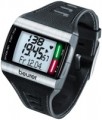Display shape
The shape of the display provided in the design of the device. In this case, there are two main types of displays — round and rectangular. However, it is worth noting that such a division is very arbitrary, and the groups themselves are very extensive: for example, round displays are oval and egg-shaped, some of them resemble rectangles with extremely rounded corners; a classic rectangular display can be placed in a round case, etc. In addition, its shape practically does not affect the functionality of the display. Therefore, when choosing, you should focus not so much on the form as on the type of display (see below), the features of displaying various data on it and the general compliance with your aesthetic preferences.
Features
—
Clock. Classic clock — a function of displaying the current time.
The clock provides not only time tracking, but also some other features — for example, they are mandatory for devices with an alarm clock (see below).
—
Alarm clock. The presence in the device of the alarm clock function — the sound signal at a specified time. In the simplest models, this signal can only be programmed for one specific time, more advanced devices allow you to remember several alarms, and if you have a calendar (see below), you can also set them on certain days (for example, only on weekdays or even on specific dates) .
—
Calendar. The device includes a calendar function, displaying at least the current date, and some models may offer advanced features like viewing monthly dates in table form. Calendar data is often used by other functions, ranging from the built-in training diary to the alarm clock.
—
Stopwatch. The device can function as a stopwatch, measuring time intervals with high accuracy, down to tenths or even hundredths of a second. The
stopwatch starts and stops at the user's command, and many models offer special measurement modes, including recording intermediate results or the time of each individual lap. This makes stopwatches significantly mor
...e convenient for measuring time intervals than regular watches.
— Timer. The ability to operate the device as a timer — that is, in the countdown mode, with a signal at the end of the specified segment. This feature will be useful when performing exercises that are clearly limited in time: setting a timer and waiting for a signal is more convenient than constantly looking at the clock.
— Lap counter. The device has the capability to record data (time, speed, calories burned, average heart rate, etc.) for each individual lap, such as during running. Typically, this is achieved with a designated "Lap" button that, when pressed, captures data for that lap and initiates a new countdown. This function enables monitoring of training dynamics, identifying the most effective laps, while simultaneously recording overall training data. Some devices also offer a lap countdown feature, where the user sets a specific number of laps, and the device signals the end of the workout after that set number is completed. This simplifies the process of tallying the total number of laps.
— Multisport. The device includes a "multisport" function designed to enhance usability during multisport activities — training or competitions involving various sports stages. While non-specialized devices can be used for such activities, those with the dedicated "multisport" feature offer greater convenience. Optimized for this mode of use, they feature built-in software modes like "Running" or "Rowing" that can be easily switched between. These devices save complex data in a format conducive to further processing and analysis.Waterproof
The degree of water protection provided for in the design of the device.
The specified underwater depth for device functionality is often given, but it's important to note that these values are somewhat arbitrary and don't accurately reflect real-world water resistance. The assessments only consider static pressure, neglecting dynamic pressure created by movement, including immersion.
Effectively, genuine water resistance can only be claimed at a minimum of 30m. Even then, such capabilities only withstand minor exposure like rain. Brief water exposure, like
swimming, might be permitted at 50m (not universally). For depths of 2 — 3m, 100m is necessary, and serious diving requires a minimum of 200m (or 300m for depths exceeding 20m).
Built-in memory
The device has
its own built-in memory.
Almost every sophisticated electronic device has a certain amount of memory, but here we specifically refer to permanent memory. This type of memory is ideal for long-term data storage, ensuring information is retained even during power outages. Its presence enables the device to operate autonomously, storing training logs, individual settings, and other essential data without the need for communication with other devices.
PC connection
The device has the capability
to connect to a PC, typically through a wired USB interface. This connection serves an auxiliary role, occurring outside of workout sessions, such as between workouts. It is utilized for various purposes, including saving collected data on a computer, adjusting settings, updating firmware, etc. The specific functionalities depend on the model of the heart rate monitor or pedometer.

